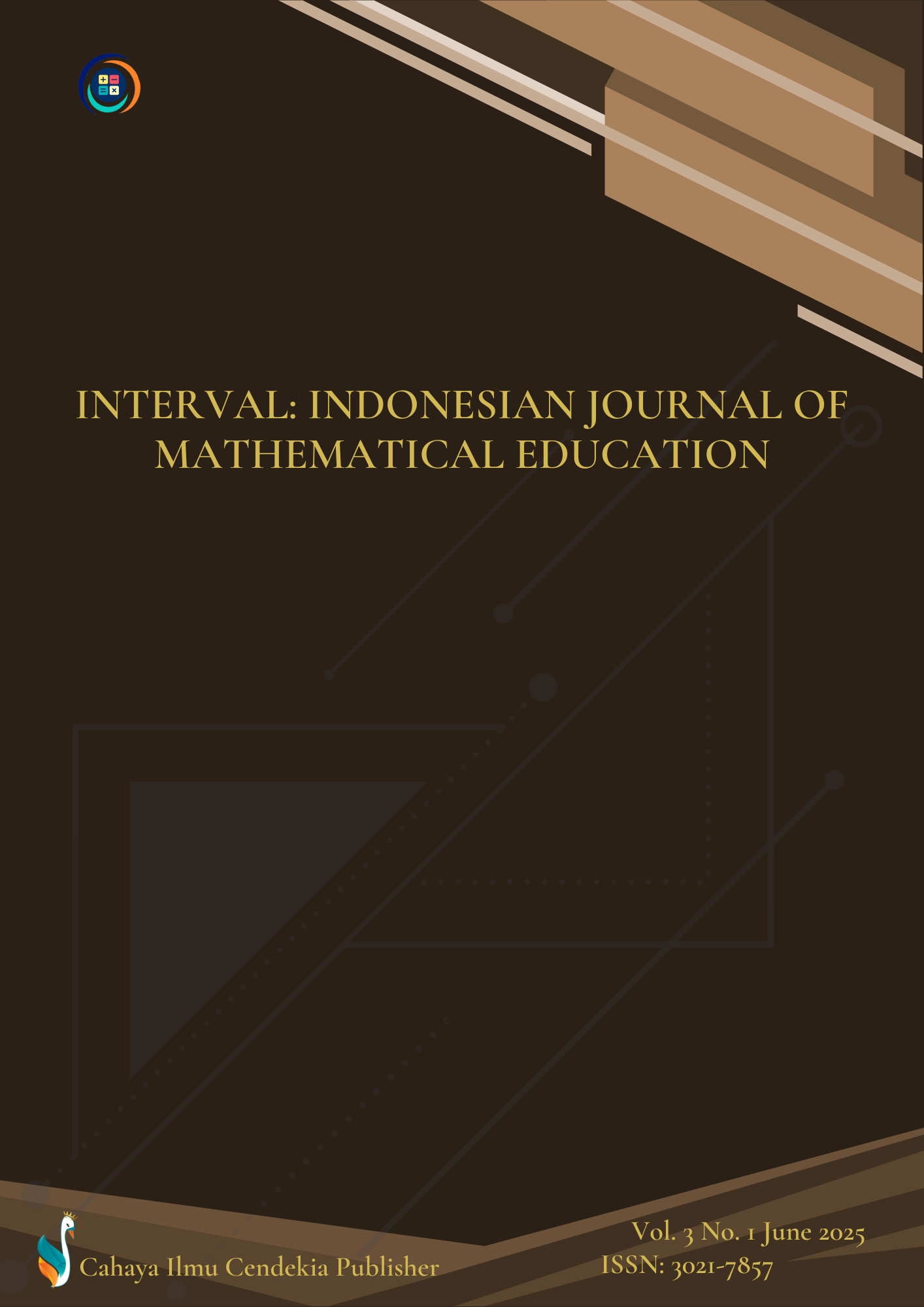Fun Strategies for Learning Mathematics: Exploring the Potential of Combinatorial Game Theory in Discrete Mathematics
Abstract
Purpose of the study: This study aims to examine the effectiveness of using combinatorial game theory in discrete mathematics learning to improve students' understanding and interest in learning.
Methodology: Using the Mixed Methods approach, quantitative data were collected through a quasi-experimental design with a pretest-posttest control group, while qualitative data were obtained through interviews and observations. The sample consisted of 60 grade XI students divided into experimental and control classes.
Main Findings: The results of the analysis showed that the average gain score of students' conceptual understanding in the experimental class (0.68) was significantly higher than the control class (0.32) with a t-test significance value of 0.001 (p < 0.05). In addition, the motivation questionnaire showed an increase in the average score from 2.9 to 4.1 on a Likert scale of 1–5.
Novelty/Originality of this study: Qualitative findings reinforce that game-based strategies encourage active participation, collaboration, and positive perceptions toward discrete mathematical theory.
References
A. M. Alzoebi, M. A. Ghunaimat, and E. A. Alawneh, “The effects of flipped classroom strategy based on ‘addie model’ for algebraic skill development,” Anatol. J. Educ., vol. 8, no. 1, pp. 141–158, 2023, doi: 10.29333/aje.2023.8110a.
F. M. van der Kleij, “Comparison of teacher and student perceptions of formative assessment feedback practices and association with individual student characteristics,” Teach. Teach. Educ., vol. 85, pp. 175–189, 2019, doi: 10.1016/j.tate.2019.06.010.
D. Setiawan, “The development of authentic assessment instrument to expand the character values of citizenship education at primary school No 104202 and No 106811 Bandar Setia, Medan, Indonesia,” Budapest Int. Res. Critics Linguist. Educ. J., vol. 2, no. 1, pp. 79–90, Feb. 2019, doi: 10.33258/birle.v2i1.188.
S. Suherman and T. Vidákovich, “Assessment of mathematical creative thinking: A systematic review,” Think. Ski. Creat., vol. 44, no. January, 2022, doi: 10.1016/j.tsc.2022.101019.
N. Rohmawati, Z. Otaiwi, W. Nakkhasen, and N. P. Thãnh, “Increasing mathematics learning activities through numbered heads together ( NHT ) cooperative learning models in students,” vol. 1, no. 1, pp. 1–7, 2023, doi: 10.37251/ijoma.v1i1.608.
O. A. Ivanov, V. V. Ivanova, and A. A. Saltan, “Likert-scale questionnaires as an educational tool in teaching discrete mathematics,” Int. J. Math. Educ. Sci. Technol., vol. 49, no. 7, pp. 1110–1118, 2018, doi: 10.1080/0020739X.2017.1423121.
J. R. Jungck, “Biological models for finite mathematics,” Primus, vol. 32, no. 3, pp. 304–345, 2022, doi: 10.1080/10511970.2021.1877515.
L. H. Rubel, V. Y. Lim, M. Hall-Wieckert, and M. Sullivan, “Teaching mathematics for spatial justice: an investigation of the lottery,” Cogn. Instr., vol. 34, no. 1, pp. 1–26, 2016, doi: 10.1080/07370008.2015.1118691.
W. Westera, “Simulating serious games: a discrete-time computational model based on cognitive flow theory,” Interact. Learn. Environ., vol. 26, no. 4, pp. 539–552, 2018, doi: 10.1080/10494820.2017.1371196.
I. Yaesh and U. Shaked, “Game theory approach to state estimation of linear discrete-time processes and its relation to H∞ -optimal estimation,” Int. J. Control, vol. 55, no. 6, pp. 1443–1452, 1992, doi: 10.1080/00207179208934293.
Q. F. Yang, C. J. Lin, and G. J. Hwang, “Research focuses and findings of flipping mathematics classes: a review of journal publications based on the technology-enhanced learning model,” Interact. Learn. Environ., vol. 29, no. 6, pp. 905–938, 2021, doi: 10.1080/10494820.2019.1637351.
J. M. Linhart, “Mastery-based testing to promote learning: experiences with discrete mathematics,” Primus, vol. 30, no. 8–10, pp. 1087–1109, 2020, doi: 10.1080/10511970.2019.1695236.
P. Grossman, K. Hammerness, and M. McDonald, “Redefining teaching, re-imagining teacher education,” Teach. Teach. Theory Pract., vol. 15, no. 2, pp. 273–289, 2009, doi: 10.1080/13540600902875340.
G. Dishon, “The new natural? Authenticity and the naturalization of educational technologies,” Learn. Media Technol., vol. 46, no. 2, pp. 156–173, 2021, doi: 10.1080/17439884.2020.1845727.
T. Djudin and S. Grapragasem, “The use of pictorial analogy to increase students achievement and its retention of physics lessons of direct current,” J. Penelit. Fis. dan Apl., vol. 9, no. 2 SE-Articles, pp. 140–151, Dec. 2019, doi: 10.26740/jpfa.v9n2.p140-151.
L. S. Ling and S. Krishnasamy, “Information technology capability (ITC) framework to improve learning experience and academic achievement of mathematics in Malaysia,” Electron. J. e-Learning, vol. 21, no. 1, pp. 36–51, 2023, doi: 10.34190/ejel.21.1.2169.
P. Guzik and B. Więckowska, “Data distribution analysis – a preliminary approach to quantitative data in biomedical research,” J. Med. Sci., vol. 92, no. 2, pp. 81–96, 2023, doi: 10.20883/medical.e869.
I. Rosyida, T. S. N. Asih, S. B. Waluya, and Sugiyanto, “Fuzzy shortest path approach for determining public bus route (Case study : Route planning for ‘trans bantul bus’ in Yogyakarta, Indonesia),” J. Discret. Math. Sci. Cryptogr., vol. 24, no. 2, pp. 557–577, 2021, doi: 10.1080/09720529.2021.1891692.
T. P. Socrates, R. Afrizon, H. Hidayati, and R. Hidayat, “The needs analysis for an educational physics game with scientific literacy and ethnoscientific content,” J. Pendidik. Fis. dan Teknol., vol. 9, no. 1, pp. 151–162, 2023, doi: 10.29303/jpft.v9i1.5079.
P. Lavega, Q. Prat, U. S. De Ocáriz, J. Serna, and V. Muñoz-Arroyave, “Aprendizaje basado en la reflexión sobre la acción a través de los juegos tradicionales. El caso de la pelota sentada,” Cult. y Educ., vol. 30, no. 1, pp. 142–176, 2018, doi: 10.1080/11356405.2017.1421302.
E. A. Barakhsanova et al., “Transdisciplinary approach to the learning process organization in the e-learning information environment of a college,” Int. Trans. J. Eng. Manag. & Appl. Sci. & Technol., vol. 11, no. 3, pp. 1–12, 2020, doi: 10.14456/ITJEMAST.2020.53.
Y. Wulandari and B. Uwameiye, “The influence of teacher pedagogical competence and learning facilities on student learning outcomes in economics subjects,” J. Soc. Knowl. Educ., vol. 4, no. 4, pp. 138–145, 2023, doi: 10.37251/jske.v4i4.765.
P. Ly, M. Bani, V. Hariana, and P. Meok, “Development of e-modules for elementary students,” Pegem J. Educ. Instr., vol. 14, no. 3, pp. 300–310, 2024, doi: 10.47750/pegegog.14.03.28.
I. Asmal, M. A. Walenna, W. Nas, and Ridwan, “Application of local wisdom in handling waste in coastal settlements as an effort to minimize waste production,” Environ. Sustain. Indic., vol. 19, no. January, p. 100283, 2023, doi: 10.1016/j.indic.2023.100283.
M. Gök and M. İnan, “Sixth-grade students’ experiences of a digital game-based learning environment: A didactic analysis,” JRAMathEdu (Journal Res. Adv. Math. Educ., vol. 6, no. 2, pp. 142–157, 2021, doi: 10.23917/jramathedu.v6i2.13687.
S. Mulyati and H. Evendi, “Pembelajaran matematika melalui media game quizizz untuk meningkatkan hasil belajar matematika SMP,” GAUSS J. Pendidik. Mat., vol. 3, no. 1, pp. 64–73, 2020, doi: 10.30656/gauss.v3i1.2127.
B. W. Pratolo and H. A. Solikhati, “Investigating teachers’ attitude toward digital literacy in EFL classroom,” J. Educ. Learn., vol. 15, no. 1, pp. 97–103, 2020, doi: 10.11591/edulearn.v15i1.15747.
Yusnidar, Fuldiaratman, and E. P. Chaw, “A study of mixed-method: science process skills, interests and learning outcomes of natural science in junior high school,” J. Ilm. Ilmu Terap. Univ. Jambi, vol. 8, no. 1, pp. 76–89, 2024, doi: 10.22437/jiituj.v8i1.31977.
M. Haq, “A comparative analysis of qualitative and quantitative research methods and a justification for adopting mixed methods in social research . the university of bradford institutional repository,” Annu. PhD Conf. Univ. Bradford Sch. Manag., pp. 1–22, 2023.
I. S. M. Ramli, S. M. Maat, and F. Khalid, “The design of game-based learning and learning analytics,” Cypriot J. Educ. Sci., vol. 17, no. 5, pp. 1742–1759, 2022, doi: 10.18844/cjes.v17i5.7326.
M. T. Magiera and V. S. Zambak, “Exploring prospective teachers’ ability to generate and analyze evidence-based explanatory arguments,” Int. J. Res. Educ. Sci., vol. 6, no. 2, pp. 327–346, 2020, doi: 10.46328/ijres.v6i2.765.
K. Kamid, R. Rohati, H. Hobri, E. Triani, S. Rohana, and W. A. Pratama, “Process skill and student’s interest for mathematics learning: playing a traditional games,” Int. J. Instr., vol. 15, no. 3, pp. 967–988, 2022, doi: 10.29333/iji.2022.15352a.
S. Campbell et al., “Purposive sampling: complex or simple? Research case examples,” J. Res. Nurs., 2020, doi: 10.1177/1744987120927206.
H. Ames, C. Glenton, and S. Lewin, “Purposive sampling in a qualitative evidence synthesis,” BMC Med. Res. Methodol., 2019.
H. Hernandez, “Testing for normality: what is the best method,” ForsChem Res. Reports, vol. 6, no. 5, 2021.
S. Demir, “Comparison of normality tests in terms of sample sizes under different skewness and kurtosis coefficients,” Int. J. Assess. Tools Educ., vol. 9, no. 2, pp. 397–409, 2022, doi: 10.21449/ijate.1101295.
Z. Liu, J. X. Yu, and H. Cheng, “Approximate homogeneous graph summarization,” J. Inf. Process., vol. 20, no. 1, pp. 77–88, 2012, doi: 10.2197/ipsjjip.20.77.
N. M. Ratminingsih, A. A. I. N. Marhaeni, and L. P. D. Vigayanti, “Self-Assessment: The effect on students’ independence and writing competence,” Int. J. Instr., vol. 11, no. 3, pp. 277–290, 2018, doi: 10.12973/iji.2018.11320a.
R. Mantasiah, Yusri, M. Anwar, and Hasmawati, “Integrating linguistics theories in developing foreign language teaching material (German grammar textbook for indonesian learners),” Int. J. Lang. Educ., vol. 5, no. 3, pp. 125–134, 2021, doi: 10.26858/ijole.v5i3.20239.
J. Holguin-Alvarez, J. Cruz-Montero, J. Ruiz-Salazar, R. L. Atoche Wong, and I. Merino-Flores, “Effects of feedback dynamics and mixed gamification on cognitive underachievement in school,” Contemp. Educ. Technol., vol. 17, no. 1, pp. 1–25, 2025, doi: 10.30935/cedtech/15717.
B. Astuti, E. Purwanta, Y. Ayriza, C. P. Bhakti, R. Lestari, and H. Herwin, “School connectedness instrument’s testing with the Rasch model for high school students during the COVID-19 pandemic,” Cypriot J. Educ. Sci., vol. 17, no. 2, pp. 410–421, 2022, doi: https://doi.org/10.18844/cjes.v17i2.6828.
M. S. Farooq, N. Feroze, and Y. T. Kai, “Computer simulation instruction and pupils’ achievement in basic science, akure township, nigeria,” Int. Online J. Prim. Educ., vol. 6, no. 2, pp. 30–38, 2017.
C. Hurdle, L. Greenhaw, and R. Biderman, “Does Autonomy Improve Satisfaction and Performance? A Case on Learner Choice,” NACTA J., vol. 68, no. 1, 2024, doi: 10.56103/nactaj.v68i1.178.
N. V. Telegina, S. E. Drovosekov, D. G. Vasbieva, and V. L. Zakharova, “The use of project activity in teaching mathematics,” Eurasia J. Math. Sci. Technol. Educ., vol. 15, no. 8, 2019, doi: 10.29333/ejmste/108439.
S. W. Lee, “Regression analysis for continuous independent variables in medical research: statistical standard and guideline of Life Cycle Committee,” Life Cycle, vol. 2, pp. 1–8, 2022, doi: 10.54724/lc.2022.e3.
C. T. Soon, H. F. Neo, and C. C. Teo, “Reading augmented reality story book in enhancing learning perceptions,” J. Logist. Informatics Serv. Sci., vol. 9, no. 4, pp. 105–118, 2022, doi: 10.33168/LISS.2022.0408.
S. G. U. Lala, P. Prabowo, and S. Suryanti, “The effectiveness of integrated learning of immersed models to improve students’ ability on the environment,” vol. 212, pp. 205–207, 2018, doi: 10.2991/icei-18.2018.45.
I. Gelen Assoc, “Academicians’ predictions of 21 st century education and education in the 21 st century,” Eur. J. Educ. Stud., vol. 4, pp. 165–204, 2018, doi: 10.5281/zenodo.1233478.
A. Nor, M. Yusuf, and I. Arabi, “Strategies for improving the professionalism of islamic education teachers at university,” Tafkir Interdiscip. J. Islam. Educ., vol. 5, no. 1, pp. 40–61, 2024, doi: 10.31538/tijie.v5i1.774.
N. Padilla Zea, J. L. González Sánchez, and F. L. Gutiérrez, “Collaborative learning by means of video games. An entertainment system in the learning processes,” in Proceedings - 2009 9th IEEE International Conference on Advanced Learning Technologies, ICALT 2009, 2009. doi: 10.1109/ICALT.2009.95.
R. P. M. Vieira, F. R. V. Alves, and P. M. M. C. Catarino, “A didactic engineering for the study of the Padovan’s combinatory model,” Pedagog. Res., vol. 9, no. 3, p. em0206, 2024, doi: 10.29333/pr/14441.
Copyright (c) 2025 Leutrim Klinaku, Ledy J Elumba, Nada Mohammed Abbas

This work is licensed under a Creative Commons Attribution 4.0 International License.
Authors who publish with this journal agree to the following terms:
- Authors retain copyright and acknowledge that the Interval: Indonesian Journal of Mathematical Education is the first publisher licensed under a Creative Commons Attribution 4.0 International License.
- Authors are able to enter into separate, additional contractual arrangements for the non-exclusive distribution of the journal's published version of the work (e.g., post it to an institutional repository or publish it in a book), with an acknowledgment of its initial publication in this journal.
- Authors are permitted and encouraged to post their work online (e.g., in institutional repositories or on their website) prior to and during the submission process, as it can lead to productive exchanges and earlier and greater citation of published work.





.png)
.png)













